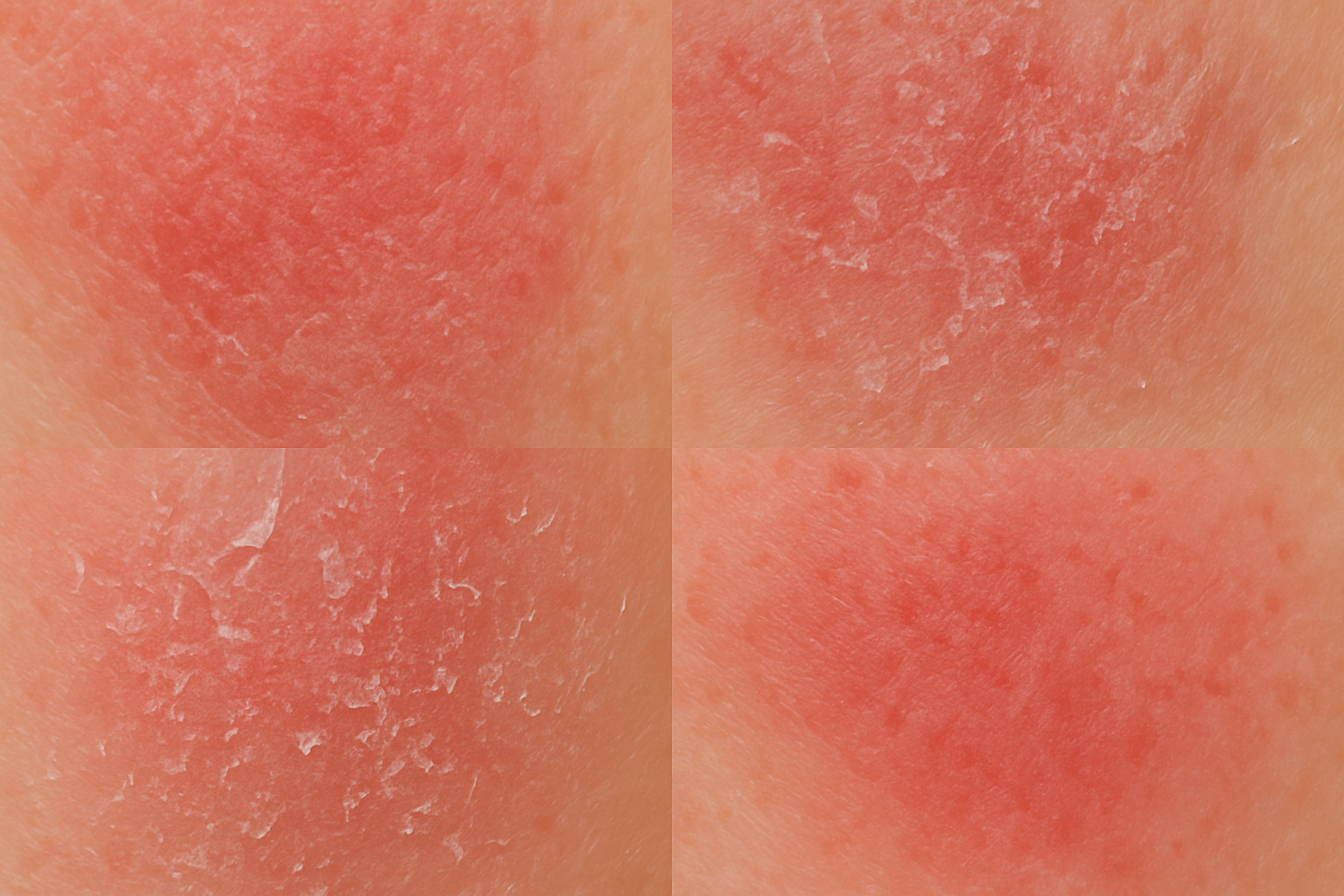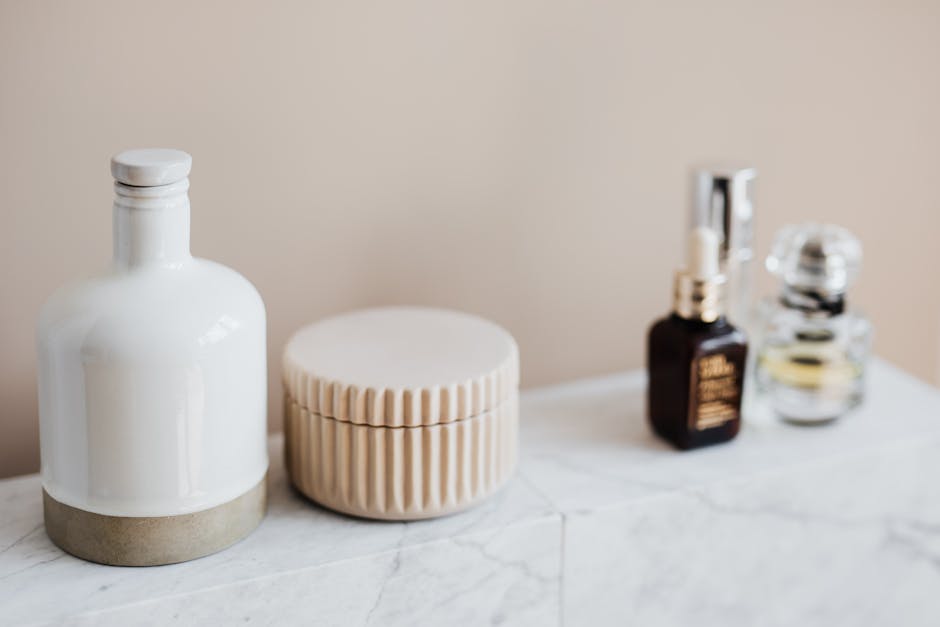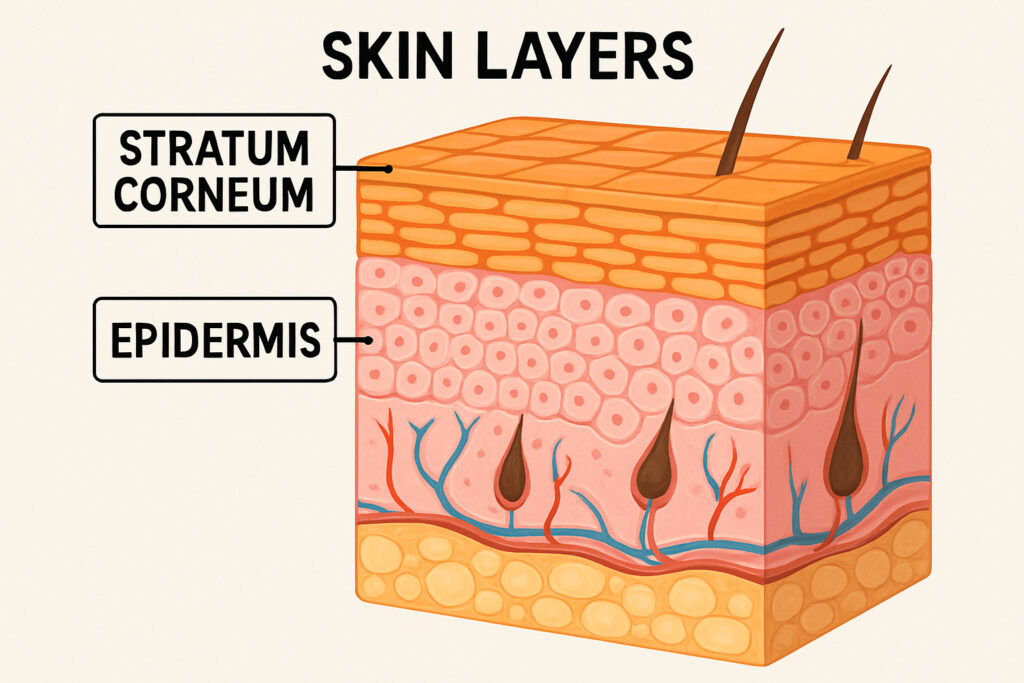Why Skin Barrier Protection is Your Skin’s Most Important Defense System
What is the Skin Barrier and Why Does It Matter?
Your skin barrier protection system is working around the clock to keep you healthy – and most of us don’t even realize it’s there. This incredible protective layer, called the stratum corneum, is only about 10-20 micrometers thick. To put that in perspective, it’s thinner than a single strand of hair, yet it’s literally keeping you alive every single day.
Located in the outermost part of your epidermis, this thin layer performs some pretty amazing feats. It’s packed with corneocytes (dead skin cells filled with tough keratin protein), surrounded by a complex mix of lipids including ceramides, cholesterol, and fatty acids. These work together with Natural Moisturizing Factors (NMFs) – special water-attracting compounds that keep your skin hydrated from within.
Here’s something that might surprise you: about a liter of moisture evaporates from your skin every single day through a process called transepidermal water loss. Without a healthy barrier, you’d literally dry out like a raisin. That’s how crucial this thin layer really is.
The “Brick and Mortar” Structure
Scientists love to describe the brick wall structure of the skin barrier, and it’s not just a cute analogy – it’s exactly how your skin actually works. The corneocytes act as protective bricks, while the lipid matrix serves as the mortar holding everything together in perfect harmony.
This design is incredibly smart. Your corneocytes are flattened and overlap like roof shingles, creating multiple layers of protection. Between them, the lipid matrix forms organized sheets that decide what can pass through your skin and what gets blocked out. It’s like having a bouncer at the door of your body.
The keratin packed inside each corneocyte gives your skin its strength – tough enough to handle daily wear and tear. Meanwhile, the lipid matrix keeps things flexible so your skin can move and stretch without cracking. It’s the perfect balance of structural integrity and water retention.
The Acid Mantle: Your Skin’s Protective Shield
Your skin naturally maintains a slightly acidic pH of around 4.7, creating what scientists call the “acid mantle.” This isn’t random – the importance of the acid mantle for skin health is backed by solid research.
This acidic environment is like having a security system that never sleeps. Harmful bacteria, viruses, and fungi struggle to survive in these acidic conditions, while your skin’s natural enzymes work optimally at this pH level. The acid mantle also helps keep your barrier lipids properly organized and supports your skin’s natural healing processes.
When your skin’s pH becomes too alkaline (above 7), you’re essentially rolling out the red carpet for troublemakers. This is why using harsh, alkaline soaps can be so damaging – they disrupt your natural protective chemistry and leave your skin vulnerable.
Key Functions for Overall Health
The vital role of the skin barrier in keeping you alive goes way beyond just looking good. Your barrier is constantly preventing water loss while allowing controlled moisture release for temperature regulation. Without it, you’d face severe dehydration within hours.
It also acts as your personal bodyguard against UV radiation, pollutants, and toxins. Every day, your skin blocks harmful chemicals from entering your bloodstream – everything from cleaning products to environmental pollutants gets stopped at the door.
Your barrier works closely with immune cells to recognize and respond to potential threats, serving as the first line of defense for your entire immune system. It even helps maintain homeostasis by regulating water loss and blood flow to keep your body’s core temperature stable.
Think of your skin barrier as the ultimate multitasker – protecting, regulating, and maintaining your health 24/7. When it’s working properly, you barely notice it’s there. But when it’s damaged, your whole body feels the difference.
Signs of a Damaged Skin Barrier and What Causes It

Your skin has a way of telling you when something’s wrong – tightness after cleansing, dullness, or products that suddenly sting can all signal trouble. As damage progresses, look for persistent dryness, itchiness, redness, or acne flares. In severe cases, cracks may form and healing slows.
Common Causes of Skin Barrier Damage
Over-exfoliation, harsh cleansers, hot water, low humidity, sun exposure, air pollution, stress, lack of sleep, aging, and genetics all strain the barrier. Psychological stress alone can raise cortisol and weaken skin within hours. Seasonal dryness? Our guide on How to Create a Minimalist Skincare Routine for Dry Winter Skin is full of practical tips.
How Your Skincare Routine Might Be the Culprit
Alkaline soaps, over-washing, abrasive scrubs, or stacking too many strong actives create micro-damage that compounds daily. Switch to gentle, pH-balanced products and introduce potent ingredients slowly. Looking for milder actives? Explore Retinol Alternatives for Sensitive Skin Types.
Your 5-Step Guide to Skin Barrier Protection and Repair

A complex routine isn’t required for healthy, resilient skin – consistency and the right choices are. Follow these five streamlined steps and you’ll support your skin barrier protection without overwhelming your schedule or budget.
Step 1: Simplify and Cleanse Gently
-
Choose a pH-balanced cleanser (4.0 – 5.0) that’s sulfate-free.
-
Use lukewarm water and massage for 30 – 60 seconds.
-
Pat – don’t rub – dry, then moisturize while skin is slightly damp.
Research on cleansing with a pH between 4.0 and 5.0 confirms this approach minimizes disruption to the acid mantle. For cleaner formulas, see our Non-Toxic Skincare guide.
Step 2: Exfoliate with Caution
Your skin already sheds tens of thousands of cells every minute, so less really is more.
-
Exfoliate just once or twice a week.
-
Opt for mild chemical options such as lactic or mandelic acid, or gentle fruit enzymes.
-
Skip gritty scrubs and rough washcloths – they create micro-tears.
Dermatology guidelines on safe exfoliation stress stopping immediately if you notice tightness, redness, or stinging. Need natural ideas? Check our Natural Exfoliation Methods.
Step 3: Use Targeted Ingredients
-
Ceramides rebuild the lipid matrix.
-
Niacinamide (5-10%) boosts natural ceramide production and calms inflammation.
-
Hyaluronic acid and glycerin act as powerful humectants.
-
Essential fatty acids (linoleic-rich oils), squalane, and barrier-friendly plant oils round out the mix. See our Ingredient Glossary: Clean Beauty Terms You Should Know for deeper insight.
Step 4: Moisturize to Lock in Hydration
Great moisturizers combine humectants, emollients, and occlusives. Apply to damp skin, use gentle upward strokes, and reapply whenever skin feels tight. Curious about product layering? Read How to Layer Serums and Moisturizers Correctly. During cold months, indulge in our Best Hydrating Face Masks for Winter Skin.
Step 5: Never Skip Sunscreen
Daily broad-spectrum SPF 30+ is non-negotiable. UV rays dismantle collagen, oxidize lipids, and undermine every other barrier-repair effort. Apply as the last step each morning and reapply every two hours outdoors. Oily or breakout-prone? See Best Sunscreens for Oily and Acne-Prone Skin.
Stick to these five essentials, and you’ll notice a calmer, stronger complexion within weeks – proof that smart, minimal routines really can deliver maximum skin barrier protection.
Frequently Asked Questions about Skin Barrier Health
How long does it take for the skin barrier to heal?
Improvements in skin barrier protection can be felt in days and seen in 1 – 2 weeks, but full recovery generally follows the skin’s 28-day renewal cycle. Severe damage, age, or underlying conditions may stretch this to eight weeks. The fastest results come from daily, uninterrupted use of a gentle routine.
Can a damaged skin barrier cause acne?
Yes. A compromised barrier allows irritants in and moisture out, which ramps up inflammation, alters the skin’s bacteria balance, and may trigger compensatory oil production – all ingredients for breakouts. Repair the barrier first, then add actives slowly. For gentle approaches, see Low-Impact Skincare for Acne Rosacea.
How does eczema relate to the skin barrier?
Eczema is often described as a barrier disorder. Many sufferers have filaggrin gene mutations and reduced ceramide levels, leading to higher water loss and chronic inflammation. Intensive moisturizing and lipid-rich products help close these “leaks.” Our full strategy is outlined in Skincare for People with Eczema-Prone Skin.
Conclusion: Nurture Your Barrier for Healthy, Glowing Skin
Think of skin barrier protection as an investment in your future self. Every gentle cleanse, every careful moisturizer application, and every day you remember sunscreen is a gift to the skin you’ll have tomorrow, next year, and decades from now.
Your skin barrier has been your silent guardian since day one, working 24/7 to keep you healthy and protected. It deserves the same consistency and care you’d give any other vital organ – because that’s exactly what it is.
The five steps we’ve covered aren’t just a skincare routine; they’re a lifestyle approach to skin barrier protection. When you choose that gentle, pH-balanced cleanser over harsh soap, you’re choosing long-term skin health over short-term squeaky-clean feelings. When you resist the urge to over-exfoliate, you’re choosing patience over instant gratification.
What makes this approach so powerful is that it works with your skin’s natural processes instead of against them. Your skin already knows how to heal and protect itself – we just need to give it the right tools and get out of its way.
The results speak for themselves. Within just a few weeks of consistent barrier-supporting care, most people notice their skin feels more comfortable, looks more radiant, and reacts less to environmental stressors. That’s not magic – that’s what happens when you support your skin’s natural intelligence.
But here’s something fascinating: taking care of your skin barrier affects more than just your complexion. Research reveals deep connections between skin health and overall wellness. Your skin barrier health can influence your immune system, stress levels, and even digestive health. For a deeper dive into these connections, check out our article on The Connection Between Gut Health and Glowing Skin.
At Beyond Beauty Lab, we believe in the power of understanding your skin from the inside out. When you know why certain ingredients work and how your skin functions, you make better choices. You stop chasing trends and start building a sustainable routine that actually works for your unique skin.
Healthy skin isn’t about perfection – it’s about resilience. A well-maintained barrier can handle life’s ups and downs, from stressful weeks to seasonal changes to the natural aging process. It’s about creating skin that feels comfortable in its own… well, skin.
Your journey to better skin barrier protection starts with a single step. Maybe it’s switching to a gentler cleanser, or finally committing to daily sunscreen use. Whatever it is, start today. Your future self will thank you.
Ready to give your skin the barrier support it deserves? Explore our clean beauty products to support your skin and find how the right ingredients can transform your skin health journey from the ground up.







